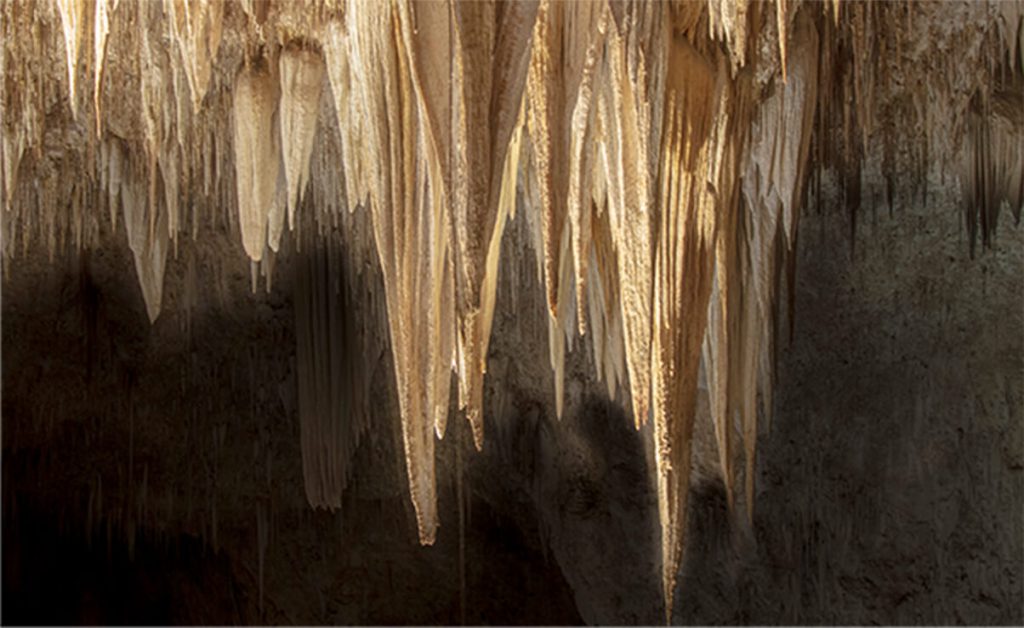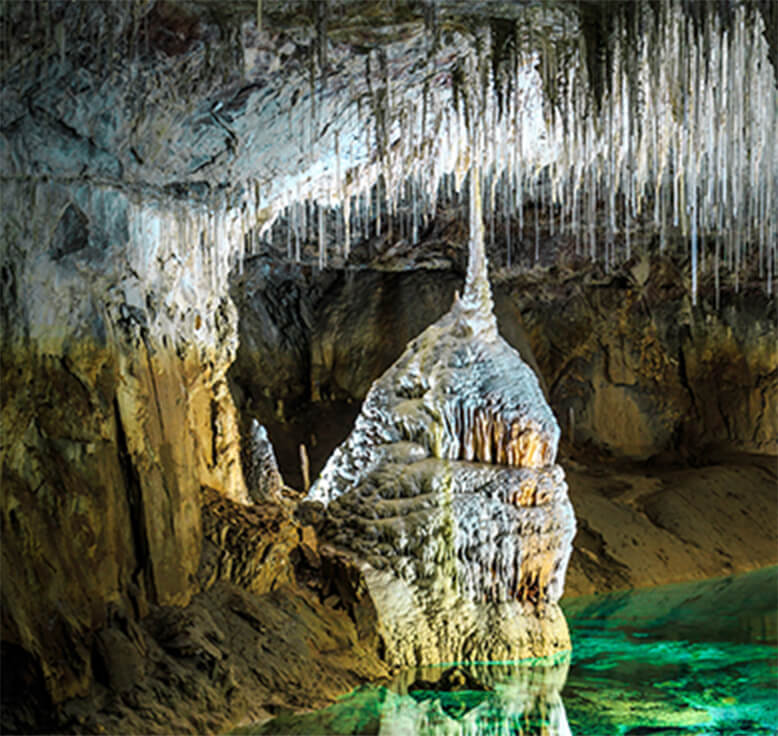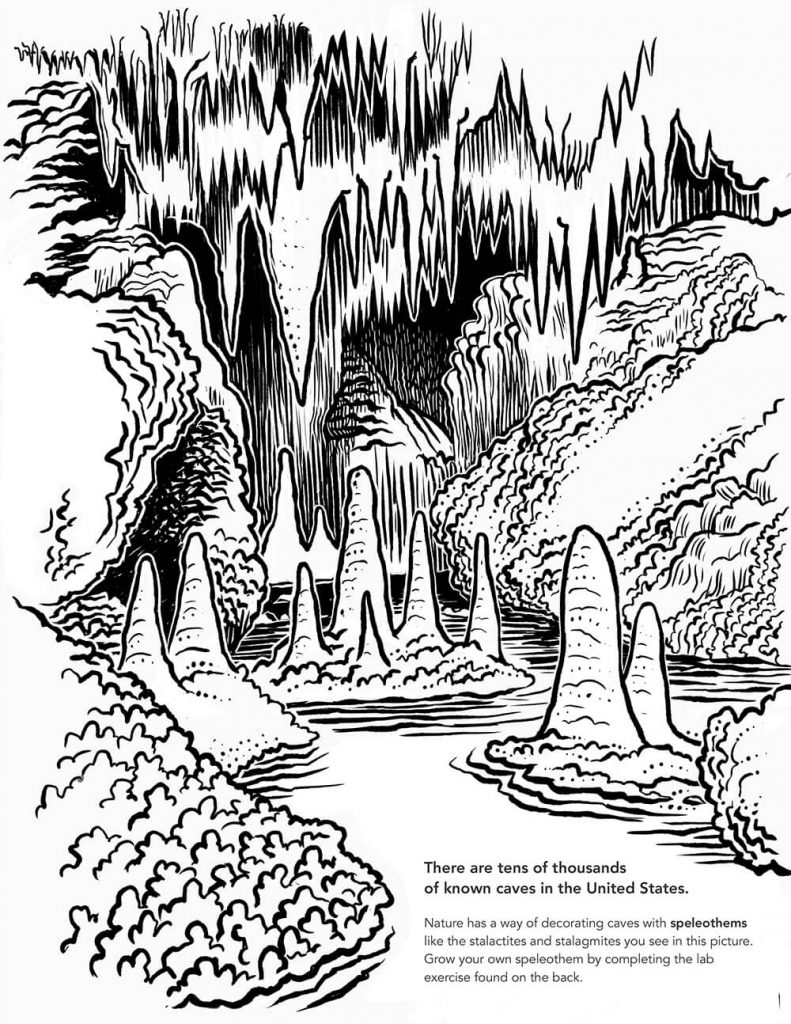Formations
The surreal-looking nature of cave landscapes is intriguing and mysterious. Oftentimes, caves are referred to as “decorated.” Cave decorations, commonly called “cave formations,” are properly called “speleogens” and “speleothems” and form or decorate cave ceilings, walls, and floors. Cave decorations are often named, in many cases for what they resemble, such as an animal, person, or building. They become landmarks to explorers (“Turn left at the Castle”). Cave formations can also become iconic or famous when people relate to a formation’s beauty or story and associate it to a particular cave.


Speleogens
Speleogens are distinctive sculpted forms in a cave’s walls, ceiling, and floors. They are created as the cave forms. One of the most common examples are scallops, which look like someone took a spoon and scooped out part of the rock. They form by flowing water. Their size and shape can be used to calculate how fast the water flowed when they were created. Very different examples are fins of rock that extend from floors, ceilings, and walls, where water eroded the surrounding rock to leave these blades of stone behind. In lava tubes, speleogens form in different ways, typically when the lava flow stops, cools, and hardens in a variety of shapes.


Speleothems
Speleothems are secondary deposits on cave walls, ceilings, and floors. They are structures with many shapes, sizes, and ages. They typically form by deposition of minerals from water both above and below the water table. Speleothems formed above the water table are the most common and are divided into two major types: dripstone and erratic.
Dripstone type speleothems form by the downward flow and dripping of water. Limestone caves generally form as water (in the atmosphere and in the soil) picks up carbon dioxide to form carbonic acid. When the carbonic acid comes into contact with the limestone, it dissolves the limestone. The dissolved limestone is carried as calcium ions in solution into the cave. When the liquid comes into contact with the air inside the cave, the reverse happens. Carbon dioxide is released from the water into the cave atmosphere, making the water less acidic and allowing the calcium ions to crystalize as the mineral calcite. Speleothems can also form from many other minerals but are less common.
Stalactites and stalagmites are the two most common types of dripstone speleothems. Over time, drip by drip, stalactites grow downward from a cave’s ceiling or ledge. Like icicles in shape and growth, they increase in length and decrease in diameter as the calcium-rich water flows down their sides and drips off the end. Where water dribbles down a cave wall, ribbons of calcite may be deposited. If the ribbons become large enough, they are called “curtains” or “draperies” and stalactites may hang off their edges.
Stalagmites are deposited on the cave floor and grow upward by dripping water. The shape of the stalagmite is based mostly on the rate the water is dripping and from how many points on the ceiling the water drips. When there are many drips in one general area or a very fast drip from the ceiling, stalagmites will form with a broad, large diameter, base with a dome-shaped top. Slower drip rates will allow for water evaporation to occur between drips, so the stalagmite will tend to grow narrow and tall.
Sometimes a stalagmite and stalactite will grow in a pair, with the stalactite directly above the stalagmite. If the two should grow together, the speleothem is called a “column.” Where thin sheets of water flow on the cave flow, often from the base of a stalagmite, they deposit sheet-like layers of calcite called “flowstone.”
Erratic speleothems form not from dripping or flowing water but from various processes involving capillary action, splashing, and different conditions in chemistry, surface texture, cave environments, and microorganisms. Some erratic speleothems include helictites, cave popcorn, and pool fingers.
As speleothems form and grow, they capture a picture of Earth’s past. Within their crystals are microscopic bubbles of air and water which are archives of meteorological data. Some are studied by scientists to learn about past precipitation, temperature, and vegetation changes over the past millennia in a cave’s area. Scientists do this using a variety of dating methods to measure the age of speleothems and their individual growth layers.
Are you an educator?
Download NCKRI’s Make Your Own Speleothem coloring sheet.

